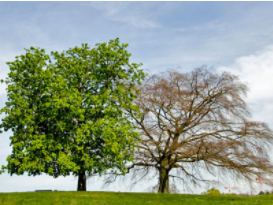It can be difficult to notice when something is not quite right with your tree. The first signs of a sick tree can be quite subtle, but if you know what to look for there is a high chance your tree can recover. Below we will outline a few of the common signs of a sick tree and how you can go about spotting them.
Branches
Depending on the type of tree, it may be a little difficult to get a proper look at the branches, but it’s necessary. Gently peel back some foliage and check for any irregularities amongst the branches. Do you see any cracks, particularly where the branch meets the trunk? Are any of your branches growing fungus? These are both signs. of structural issues with your tree, often related to decay. Have any branches broken off from your tree? Are any branches completely bare, lacking any foliage? These two signs are easier to spot and a generally good indicator that there is something wrong with your tree that should be investigated further.
Leaves
Leaves are the first thing we notice on a tree, so they also tend to be the first thing we notice when something seems a little off. When checking your tree’s leaves, it’s important to keep in mind the current season. It’s fine for a tree to be bare going into the winter seasons, but as spring rolls around the foliage should return as vibrant as ever. If any part of your tree’s leaves appears to be thinner or slightly discolored in places, your tree may not be getting enough nutrients. Insect damage is also easy to see on the leaves of your trees, so any signs of bites or leaf decay could mean you have an insect problem that is damaging your tree.
Roots
Although most of your tree’s roots will be underground, any evidence of root issues should show a little closer to the surface. Examining the base of your tree’s trunk can give some idea of how healthy it’s roots are. Check for mushrooms or other fungi growing around the base of your tree, as well as any sections that are falling away or splitting apart from the roots. If the roots of your tree are visible, check for any large gaps or holes in the roots. These could all be signs of root decay.
Trunks
Your tree’s trunk is its main source of structural integrity. Any issues with the trunk will generally indicate structural weakness or decay. Some of the things you should be looking out for are large cracks or hollows in the trunk. Any large area of missing bark is cause for concern. On the other hand, any section of your tree’s trunk that appears swollen or much thicker than the rest can signify more advanced decay. Any fungi growing on the trunk or oozing sections of tree sap can also be a sign of a sick tree.
Why Get Help From An Arborist?
An arborist is essentially a tree doctor. They generally have extensive knowledge of all plant life and can diagnose any issues with trees, including potential decay but are also involved with the overall maintenance of trees.
If you have some concerns about the health of your tree, hiring an arborist is a necessity. An arborist will be able to determine whether your tree is sick or healthy and to what extent. It should be noted that further testing may be required before a complete diagnosis of any issues with your tree. Once a diagnosis is reached, an arborist will then be able to guide you through the best course of action, whether it be to bring your tree back to a healthy state or, if the tree is too damaged, how to safely dispose of the tree. They can also provide advice on how to prevent similar issues from arising in the future.
If you have any concerns about the health of your tree, it is highly recommended that you seek out a certified arborist as soon as possible. The sooner your tree’s issues can be diagnosed, the more likely it will be that your tree can recover to full health.
